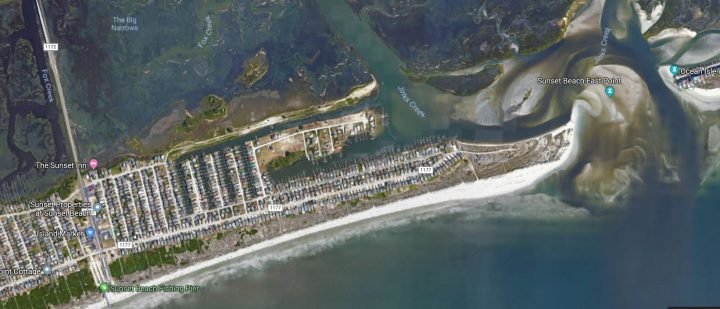
SUNSET BEACH – The Army of Corps of Engineers is broadening its review of a portion of Sunset Beach’s proposed dredging project, one that continues to draw skepticism from some of the town’s residents as well as environmental groups.
Moffatt & Nichol, an engineering firm hired by the town to oversee the project, was notified last month that the town must now apply for an individual federal permit rather than a general permit to dredge south Jinks Creek, a feeder canal and bay area of the island.
Supporter Spotlight
The change will set into motion a standard, 30-day public comment period for a project being heavily scrutinized because it includes dredging south Jinks Creek, the northern half of which has never been dredged, leads to marshes and tributaries that are designated Primary Nursery Areas (PNA), and is arguably itself a PNA.
The Corps had not announced the public notice as of publication of this report.
No portion of the creek is currently classified as a PNA by the North Carolina Marine Fisheries Commission, which makes these designations to protect habitat, particularly along bottom areas such as sand, mud, sea grasses and oyster rocks.
Jinks Creek is roughly a mile long and connects Tubbs Inlet with the Atlantic Intracoastal Waterway, providing ocean access to property owners who live on the eastern end of the Brunswick County island.
The creek supports nearly 1,200 oyster species per acre, or a little more than 50,300 total, between the Intracoastal Waterway confluence and the entrance to the feeder canal, according to a February 2018 survey conducted by Moffatt & Nichol.
Supporter Spotlight
That survey concludes that proposed dredging “may create impacts” to about 12,810 oysters and disturb an estimated 10.72 acres within the creek between the Intracoastal Waterway confluence and feeder canal.
The lingering question is what those effects may be on the portion of creek that would not be dredged.

“I don’t think any of us have any problem with dredging the feeder canal or the canal bay area,” said Sunset Beach property owner Richard Hilderman. “Our problem is with Jinks Creek. To me, the major concern is the oyster bed in (north) Jinks Creek.”
Hilderman, who is also a founding member of the Brunswick Environmental Action Team, or BEAT, and a retired biochemist, believes dredging the canal in south Jinks Creek will increase the amount of sediment collecting in north Jinks Creek.
“If you put that channel in south Jinks Creek you’re going to increase the sediment load into north Jinks Creek and then you’re going to bury the oysters,” he said. “To me, somebody has got to do a better study on what the dredging is going to do to the oysters in north Jinks Creek. I think it’s very encouraging that the Corps of Engineers is saying wait a minute, we need to take a step back and look at this.”
The town received a Coastal Area Management Act, or CAMA, major permit from the state in January to dredge Mary’s Creek and Turtle Creek as part of an overall project that includes roughly 3 miles of waterway.
Shoaling in these waterways is making it difficult for boaters to reach the Atlantic Ocean outside of a short window of opportunity that’s based on the tide, according to proponents of the dredging project.
The state Division of Coastal Management, or DCM, notified the town last December that the application to dredge south Jinks Creek, the feeder canal and bay area would have to be resubmitted because it missed several pieces of information.
Under the CAMA major permitting process, DCM heads the coordination between the various state and federal review agencies and general federal permit requirements are folded into the CAMA major permit.
Projects that receive a general federal permit are those expected to have only minor impacts to streams, wetlands and other waters.
Individual permits, which are also called standard permits, are required generally for projects with the potential for substantial environmental impacts, according to the Corps’ website.
Tyler Crumbley, a project manager with the Corps’ Wilmington district, said in an email that the Corps has a majority of the information in the general permit application, “and will just need to be referenced.”
“The next step will be to complete the requests for consultation to the (U.S. Fish and Wildlife Service) and the (National Marine Fisheries Service Protected Resources Division) with an updated Biological Assessment and effects determinations,” Crumbley said.
The Corps initially determined the work proposed for south Jinks Creek and the canals “may affect likely to not adversely affect” the environment based on the statewide programmatic biological opinion, or SPBO.
The SPBO was created in 2017 to streamline the process for beach renourishment projects by eliminating the requirement for the preparation of individual, project-specific assessments and case-by-case federal reviews.
A July 29 letter from the U.S. Fish and Wildlife Service to the Corps recommended the language in the biological assessment be revised to state the project, which includes placing dredged sand onto 1,600 linear feet of ocean shoreline, “may affect, and is likely to adversely affect” five species of sea turtles, red knot, piping plover and seabeach amaranth.
Now the Corps is requiring a project-specific biological opinion, which is part of a process known as Section 7 of the Endangered Species Act, where federal agencies consult with one another to conserve threatened and endangered species.
This could lead to a formal consultation between Fish and Wildlife Service officials and the Corps.
The biological assessment is undergoing its third revision since it was initially submitted, Crumbley said.
“The (biological assessment) pertains to the potential impacts for all components of the project proposal on species and their habitats,” he said.
That includes the potential impacts to the oysters and habitat in north Jinks Creek.
If it turns out that a formal consultation is required, the agencies have 135 days to render a biological opinion.
The Corps generally issues decisions for standard permits within 120 days.







